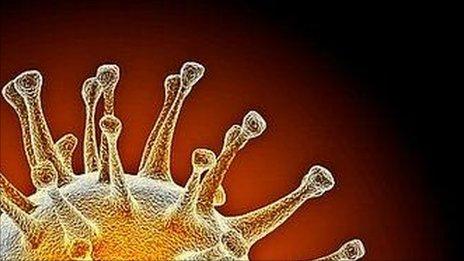When should science be censored?
- Published
- comments

H5N1 virus has killed millions of birds
In a darkened conference room in Malta in September, a Dutch scientist announced to a virology meeting that he had created a mutated strain of H5N1 bird flu which had the potential to spread between humans.
Dr Ron Fouchier, from the Erasmus Medical Center in Rotterdam, said his team had introduced a number of genetic variations - around five - which had enabled the virus to pass between ferrets - the best animal model we have for testing whether the virus will infect humans.
So while it is not certain that the Dutch team had created a deadly human strain of bird flu, it seems to be a real possibility.
This story made headlines today, external but has been around for some time. The Erasmus Medical Center issued a press statement , externallast month in which Fouchier said the discovery could help prevent a pandemic: "We now know which mutations to watch for in the case of an outbreak and we can then stop the outbreak before it is too late. Furthermore, the finding will help in the timely development of vaccinations and medication."
The assembled virologists in Malta were told the full data would be published in due course in the journal Science. But it is being held up by a review being undertaken by the US National Science Advisory Board for Biosecurity (NSABB).
The concern is that the details of the research could be misused in the wrong hands. The NSABB has asked Science to publish only an abbreviated version.
The journal's editor-in-chief Dr Bruce Alberts said they were considering what to do: "Science has concerns about withholding potentially important public‐health information from responsible influenza researchers. Many scientists within the influenza community have a bona fide need to know the details of this research in order to protect the public, especially if they currently are working with related strains of the virus."
At present H5N1 is almost exclusively an avian disease. But it is still killing people, with fatalities this year in Egypt, Iraq and Vietnam. The latest figures from the WHO, external show that 573 people have been infected since 2003, after close contact with diseased birds. 336 of them died, which gives it a mortality rate of more than 50%.
Compare that with the 1918 flu pandemic, which killed tens of millions of people. It had a mortality rate of perhaps 1%.
Fortunately the H5N1 virus does not spread between humans, but you can see why scientists remain worried about its potential.
The idea of a deadly virus sweeping the planet was the subject of a recent film, 'Contagion'. It was packed with star actors, including Kate Winslet and Jude Law. At one stage a scientist, played by Laurence Fishburne, is asked by the Pentagon if someone could have weaponised bird flu. "There's no need," replies Fishburne, "the birds are doing that".
So should the research be published in full? Definitely, according to two influenza experts I spoke to.
Professor Wendy Barclay from Imperial College London said: "This is important scientific information which researchers need to know about. It needs to be scrutinised by all of those working in the field. Rather like those experts at CERN who said they had measured neutrinos travelling faster than the speed of light and then asked other scientists to check their approach."
Bio terrorism
Professor John Oxford from Barts and the London School of Medicine agrees. "They should definitely publish. The biggest risk with bird flu is from the virus itself. We should forget about bio terrorism and concentrate on Mother Nature."
Both scientists agree that the influenza virus would make a pretty poor bio terrorist weapon, unless your aim was to spread the infection across the world. Influenza has no respect for borders, so introducing a virus in one country would inevitably spread it globally.
Professor Oxford said there was no scientific data he could think of that should be censored. "Scientists should not be looking over their shoulders. This is about human endeavour - pressing ahead and transferring knowledge to the wider world. That is the culture of science."
But Michael Parker, Professor of Bioethics and Director of the Ethox Centre at the University of Oxford, disagrees.
"The position that everything should be published is not tenable. There must be some scientific information which contains an immediate threat to public safety if it fell into the wrong hands."
Censorship
This problem was recognised in the early days of atomic physics, with scientists well aware that research into nuclear fission could be used for good or ill.
Professor Parker is not in favour of strict regulations or censorship, but supports the concept of building ethics into the work of scientists, and relying on journal editors to exercise caution.
Some of those following this blog have been doing so since its first incarnation as "Fergus on flu". I'd welcome your thoughts on the H5N1 research and on the censorship of scientific research.
Whatever else it does, this latest research reminds us that H5N1 is a virus which still has a deadly potential.
- Published30 August 2011

- Published18 November 2010